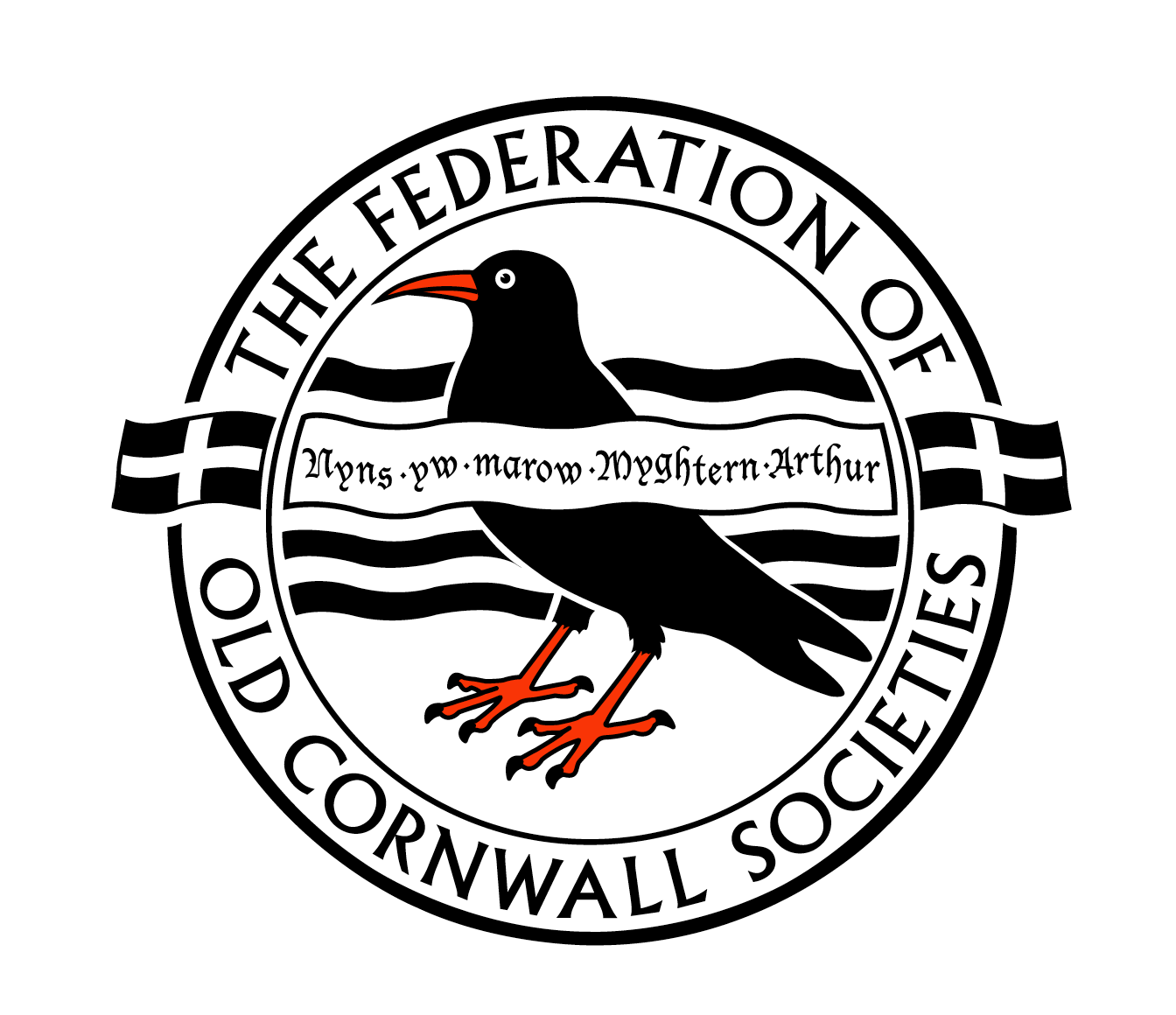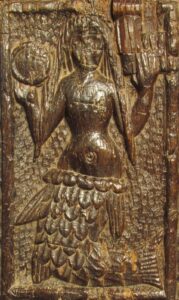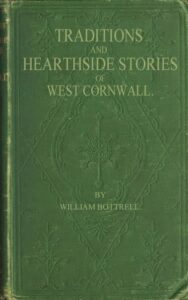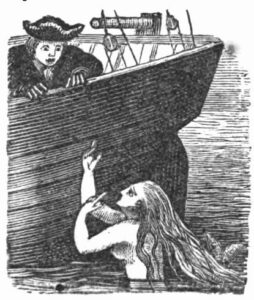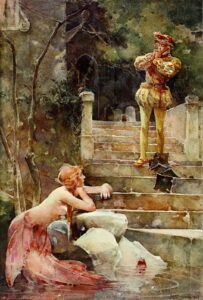Mermaid of Zennor By Bottrell
In the wild, windswept moorland of Cornwall, not far from Land's End and on the coast road to St Ives, is the little village called Zennor, and there you can find the church of St. Senara. Every year, hundreds of tourists flock to this quiet coastal village just to visit St Senara's, for it is home to a famous folkloric artefact, the Mermaid's chair. Displayed in the southern side of the church, the Mermaid's chair is an old wooden seat. It is believed to have been constructed from old bench ends, and its ornate carved sides are believed to be around 600 years old. It is adorned with a thin cushion with a pattern of fishes, and one side has a beautiful but unremarkable intertwining pattern. However on the other is a carving of mermaid, which is said to commemorate an ancient local tale.
The short version goes like this. The choristers of St, Senara were famed for their singing, however once upon a time they had a truly exceptional talent - a handsome young fellow called Matthew Trewella, whose voice was so beautiful that every service at the church would close with him singing the last hymn solo. His singing was so enchanting that a local mermaid would creep into the church to listen. However one day, the handsome Matthew noticed his mystery admirer, and being as enchanted with her as she was with him, after church he followed her. He followed her down to the sea, to Pendour Cove, and there both vanished beneath the waves and never to be seen again. And hence, the carved chair in St. Senara's is the very seat where the mermaid would sit and listen to Matthew singing... Or so the local legend says.
However modern folklorists have theorized that actually the carving probably Inspired the story and not the other way around. And in favour of that argument are the following facts. Firstly the carving dates back at least five hundred years whereas the earliest version of this fishy tale that we have comes from the 19th century. Secondly, while at first it would seem unusual to find a representation of a mermaid in a church - after all, alluring ladies who are half fish and half naked aren't normally the first thing that springs to mind when contemplating the teachings of Christ - actually mermaids have a long history in church iconography as can be seen here in this marvellous round-up of church merfolk. At various times in history they have been used to represent vanity (hence appearing with combs and mirror), the dual nature of Christ (with his human/divine nature symbolized in the mermaid's ability to live in the realm of air and the realm of water), and of course given their famous beauty and scanty wardrobes, as warnings about the temptations of lust.
On the flipside however, we must also note that we don't actually have too much folklore dated before 1800s, as quite simply it wasn't until the 19th century that people began documenting folk tales and local stories. Hence the
tale of the Mermaid of Zennor may have been circulating for untold years before it was recorded by Mr William Bottrell. So then, how old the story actually is, it is impossible to say. Secondly, while the carving's depiction of the lady from the waves has her holding a comb and mirror, which suggests a medieval reminder on the sins of vanity, we should also note that this was also the traditional way mermaids were depicted. Indeed the Greek goddess Aphrodite was often pictured as a mermaid holding a comb and a quince - and in ancient depictions of mermaids there is some confusion as to whether the round object they are holding is a mirror or a fruit. The point is however, that medieval artwork was very stylised - with artists recreating an accepted set of images and symbols rather than crafting personal visions. Hence if the villagers of Zennor had instructed a woodworker to carve them a mermaid to commemorate the tale, it is highly likely a mermaid in the classic pose with mirror and comb would have resulted anyway.
So did the tale inspired the carving or the carving inspire the tale? Well as is often the case with folklore, it is always worth having a look at the original source to see what light it can shed on the matter. And so here is what William Bottrell recorded in Traditions and Hearthside Stories of West Cornwall, Volume II (1873)
Hundreds of years ago a very beautiful and richly attired lady attended service in Zennor Church occasionally now and then she went to Morvah also; her visits were by no means regular, often long intervals would elapse between them. Yet whenever she came the people were enchanted with her good looks and sweet singing. Although Zennor folks were remarkable for their fine psalmody, she excelled them all; and they wondered how, after the scores of years that they had seen her, she continued to look so young and fair. No one knew whence she came nor whither she went; yet many watched her as far as they could see from Tregarthen Hill. She took some notice of a fine young man, called Mathey Trewella, who was the best singer in the parish. He once followed her, but he never returned; after that she was never more seen in Zennor Church, and it might not have been known to this day who or what she was but for the merest accident. One Sunday morning a vessel cast anchor about a mile from Pendower Cove; soon after a mermaid came close alongside and hailed the ship. Rising out of the water as far as her waist, with her yellow hair floating around her, she told the captain that she was returning from church, and requested him to trip his anchor just for a minute, as the fluke of it rested on the door of her dwelling, and she was anxious to get in to her children. Others say that while she was out on the ocean a-fishing of a Sunday morning, the anchor was dropped on the trap-door which gave access to her submarine abode. Finding, on her return, how she was hindered from opening her door, she begged the captain to have the anchor raised that she might enter her dwelling to dress her children and be ready in time for church. However it may be, her polite request had a magical effect upon the sailors, for they immediately "worked with a will: hove anchor and set sail, not wishing to remain a moment longer than they could help near her habitation. Seafaring men, who understood most about mermaids, regarded their appearance as a token that bad luck was near at hand. It was believed they could take such shapes as suited their purpose, and that they had often allured men to live with them.
When Zennor folks learnt that a mermaid dwelt near Pendower, and what she had told the captain, they concluded it was, this sea-lady who had visited their church, and enticed Trewella to her abode. To commemorate the somewhat unusual events they had the figure she bor e— when in her ocean-home — carved in holy-oak, which may still be seen.
Now this original account not only gives us a far fuller version of the story, but casts an interesting light on the tale. To begin with the mermaid is depicted in accordance with traditional folklore rather than Victorian fairy tales. Thanks to Hans Christian Anderson's The Little Mermaid, in the popular imagination we now assume there are rules and limiting conditions on a mermaid assuming human form, however as is demonstrated here, in many folk traditions there are no magical pacts and spells needed for a merfolk to walk on land among us, and no occult strictures on this power of transformation.
Also we hear that the sighting of a mermaid was thought to be an ill omen, which again is consistent with old folk traditions of mermaids. Indeed this may be a very ancient belief, as our word 'monster' is derived from the Latin 'monstrum' which means 'omen'. For in the ancient world, the sighting of a strange beast or creature was a sign that the forces that governed our world were out of balance - hence an unnatural being signified a disturbance in the natural world.
Most interesting however are the rough edges to this first account of the story. While later versions would have the sailors over-hearing the mermaid calling to Matthew to attend to the children, this original telling of the tale is lacking this little narrative detail that smoothly rounds off the story. And this seems somewhat strange if the tale of the Mermaid of Zennor was supposedly inspired by the carving on the chair. For considering the age of the chair, one would have expected the tale, having being told in the local area for generations, would have been rounded off over the years in much the same way it has been by various storytellers and authors in the years after Bottrell's account brought the legend to a wider public.
Now this is most unusual for a supposedly traditional tale. Stories are much like stones on a beach, over the years retellings act like the tides, slowly wearing away the jagged edges and leaving smooth curves. And as any explorer of folklore will tell you, generally the more recent the version of the tale, the smoother the story runs. So there is - if you'll pardon the pun -something fishy going on here. In the original account above we appear to have two incidents that the locals have linked together, with the second providing the explanation for the first. If that is so, the rough edges in the resulting composite tale would suggest that these two local stories were only connected relatively recently to Mr Bottrell hearing it. Or perhaps are these are two fragmentary tales that Bottrell himself connected? Those of a cynical nature may well pointedly note that the Zennor mermaid tale appears toward the end of Volume II.
On the other hand, possibly there is a grain of truth in the legend, a real life disappearance of a local fellow later "explained" by another odd event. Perhaps it is time some enterprising soul searches the parish records in search of Mathey Trewella, for that would give us some indication of the age of the tale. It would be most interesting to discover if there was such a person, and indeed if he did disappear in mysterious circumstances....
